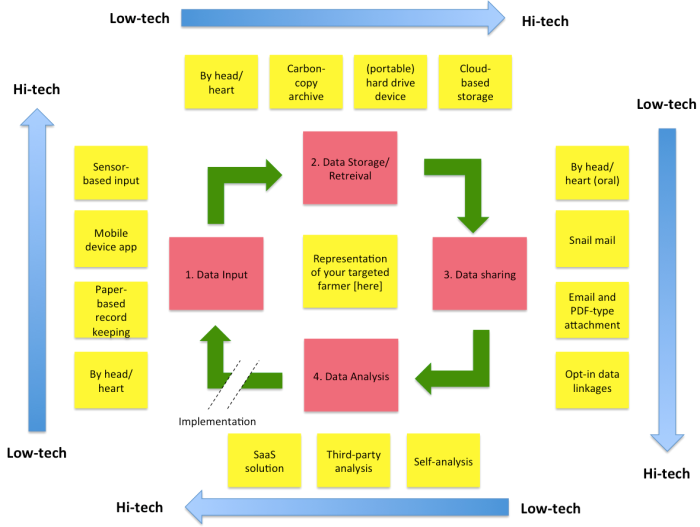The world of technology has only recently begun to design services for farmers. But the numbers show that this line of business is already growing rapidly. Investment records are broken every semester.
Underlying this development is the boon of the huge amount of data that a farm now generates. Like every other human being, farmers do book keeping, are active online, and use smartphones. They use such tools to solve problems on the farm, and by doing so, they’re generating data. There is also farm machinery, loaded with sensors generating lots of data. By combining such farm operations data with other data repositories, like open satellite data on water tables, precipitation, and nutrition data from the feed manufacturer, etc, data can be combined into useful applications that can help with farm management.
Despite the opportunity for the developer to build valuable solutions, there are also barriers that significantly obstruct adoption of digital solutions for farm management. An important barrier is created by technology solutions imposing certain implicit requirements regarding a farmer’s level of data saviness, to collect, organize, and distribute data. Even farmers who do understand the value of data management, generally don’t use computer or web-based tools.
The transfer of farm management practice to an online environment, is hardly seamless, and this transfer problem is a problem for many companies and startups that are developing services in this space. More often than not, I see solutions being launched that are at quite a distance from the kind of tech usability that a farmer can muster.
A Thinking Model
A rule of thumb for nailing product design is that you can best meet your farmers where they are. To help position where the farmers you’re targeting are in terms of tech saviness, I’ve developed a model form making farm data personas. This model is presented below.

The basic idea is that any farmer, regardless of the technology, has to follow a flow of datamanagement in order to utilize and implement insights drawn from data in the farming practice. This datamanagement flow consists of 4 steps: Data Input, Data Storage/Retrieval, Data Sharing, and Data Analysis.
For each step there are a variety of options available to the farmer to handle their data. These options range from low-tech solutions, like paper-based record keeping, to high-tech solutions, like cloud computing storage, and SaaS for analyzing farm performance. (These can of course be adapted to whatever fits the sliding technology scale that matches your own circumstances.)
Next to profiling farmers according to their tech saviness, this model can also be used to indicate what level your solution currently requires your farmers to be in. By comparing these parameters, you can start to see, and understand the gaps.
Making technology appropriate.
Lets take an example of a solution of herd management for dairy farmers. Say you have an idea for a SaaS analysis solution, to offer online software for dairy herd management, like Farmeron. You will need to figure out a way to connect all the necessary data flows to feed your analytical solution. You want farmers to somehow get their cows to the cloud for analyzing herd performance, and you’re going to need a way to get them to digitize their input.
In the case that your farmers are still working with paper-based recording keeping, which is likely, you’re probably going to have to physically on-board their data. (As stated by Matija Kopic himself, founder of Farmeron)
Once you’ve identified this gap, the question then becomes what intermediate steps you can build into your solution to take farmers up the tech ladder. Can you redesign your product to include a learning curve, which will take your farmers on a journey to comprehend your solution, take control, and eventually make it fully usable?
Sticking with the example of Farmeron, they’re streamlining their person-to-person onboarding service with other support tools to educate farmers, and keep the learning going. This is something they had to configure on the fly whilst already being deeply rooted into their developed solution.
The upshot is that agtech initiatives will likely need to design for the farmer’s learning curve. Adoption for agtech solutions will be slower, and acquisition costs relatively high compared to other tech industries. This is something startups in this space will spend of lot of time on, and their investors will need to provide for the adequate runway.
—–
Thanks to some valuable discussions I’ve had about this model with my colleagues Lan Ge, and Marc-Jeroen Boogaardt at Wageningen University in our Farm Digital project, and also with my dear wife Anne Bruinsma, who happens to be a leading figure in agtech with Hackwerk Advies.